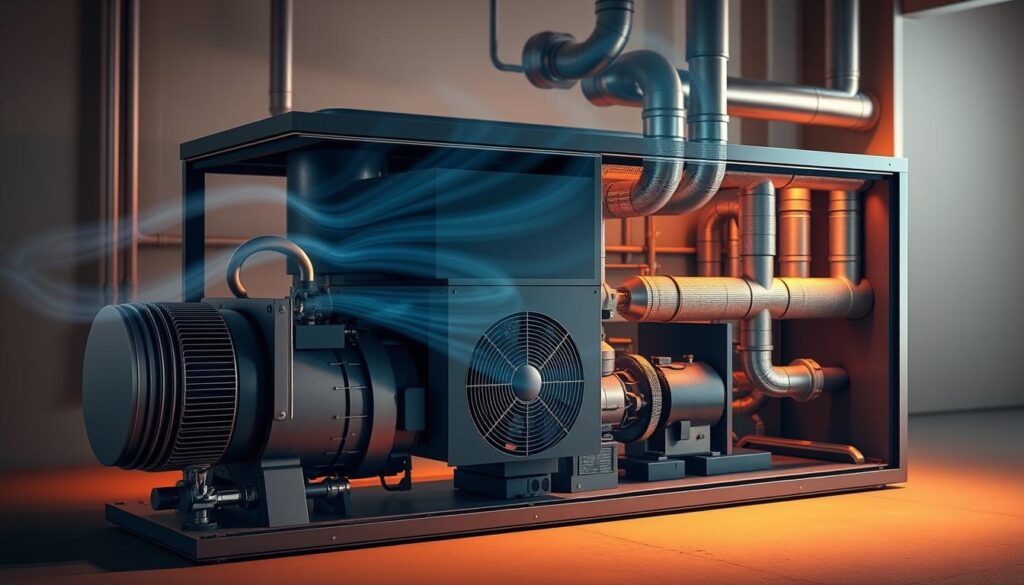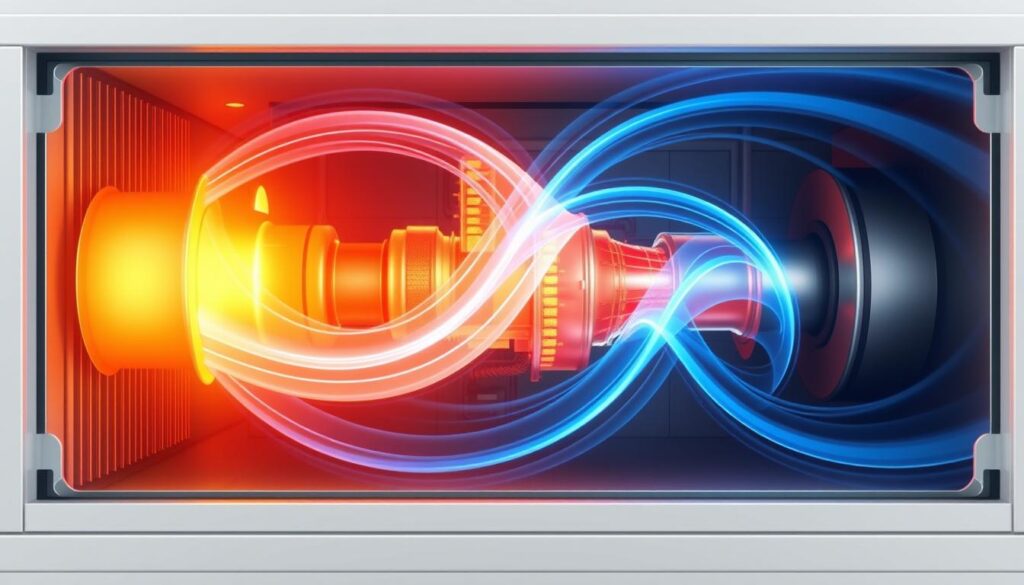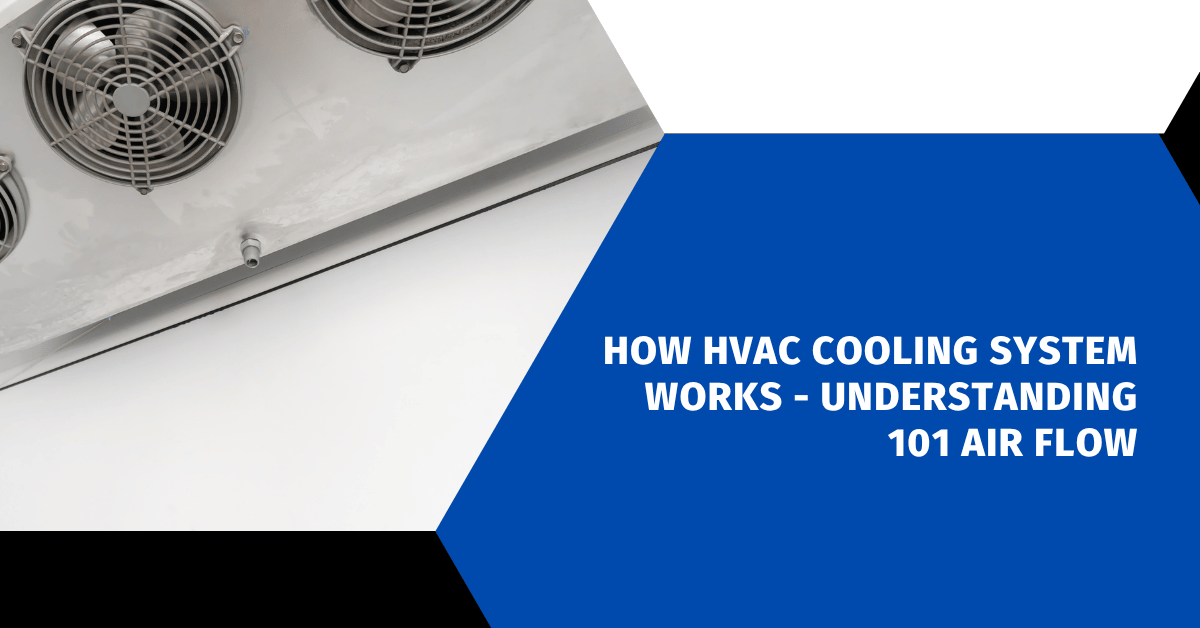Affiliate Disclosure
HVAC Guide Guys is a participant in the Amazon Services LLC Associates Program, an affiliate advertising program designed to provide a means for sites to earn advertising fees by advertising and linking to Amazon.
Ever wondered why some homes feel perfectly comfortable while others struggle with temperature control? The secret is in understanding HVAC cooling systems and the role of airflow.

Your air conditioning system does more than just cool the air. It’s a complex system that manages temperature, humidity, and air quality. When it works right, it turns your home into a cozy haven.
Knowing about airflow is key for a good air conditioning system. HVAC experts say that air movement affects how well your system cools and circulates air. Without good airflow, your system uses more energy and might raise your bills.
Today’s HVAC systems are designed to move air just right. They remove heat and moisture and filter out bad stuff. The air circulation is a complex process that involves many parts working together for the perfect indoor climate.
Key Takeaways
- HVAC systems account for 40% of home energy consumption
- Proper airflow can improve system efficiency by up to 25%
- Regular maintenance reduces unexpected breakdowns by 30%
- Air filters should be checked monthly and replaced every 90 days
- Well-maintained systems can enhance indoor air quality by 95%
Table of Contents
Understanding HVAC System Components and Their Functions
Your HVAC system is made up of many parts working together. They keep your indoor temperature comfortable. Each part is key to controlling temperature and air quality.
Modern HVAC systems have many advanced parts. They work together to cool and heat your space well. Let’s look at the main parts:
Central Air Handling System Overview
The central air handling system is the core of your HVAC. It does several important things:
- Moves air around your home
- Changes air temperature and humidity
Role of Refrigeration Units
Refrigeration units are vital for cooling. The compressor changes refrigerant’s state. Key parts are:
- Condenser coil: Releases heat
- Evaporator coil: Takes in heat
- Refrigerant: Moves thermal energy
“Efficient HVAC systems rely on perfectly synchronized components to maintain indoor comfort.” – HVAC Engineering Experts
Ductwork Distribution System
The ductwork is like your HVAC’s circulatory system. It sends cooled air to rooms. Good design and upkeep mean better airflow and energy use.
Keeping these parts in good shape helps your system work better. It also makes it last longer.
Explore Our HVAC Shop
Looking for top-rated HVAC tools, parts, and accessories? Visit our shop and find the perfect solution for your needs.
Visit the ShopThe Basic Principles of Air Movement in HVAC Systems
Knowing how air moves is key to understanding your HVAC system. Air flows like a liquid, moving from high to low pressure through ducts. This flow is at the heart of your cooling system’s work.
Fans are vital in making pressure differences for air to move. When your thermostat tells the system to cool, a complex air movement starts. The system makes higher pressure in some ducts, pushing air to lower pressure areas.
“Air movement in HVAC systems is a delicate dance of pressure and precision” – HVAC Engineering Insights
- Pressure drives air movement through ducts
- Fans create necessary pressure differentials
- Thermostat control initiates the cooling cycle
- Air naturally flows from high to low pressure zones
Several factors affect air movement:
| Factor | Impact on Air Movement |
|---|---|
| Pressure Differential | Direct proportion to air flow rate |
| Duct Resistance | Reduces air movement efficiency |
| Fan Blade Angle | Increases pressure and air flow |
Understanding these principles helps you appreciate the sophisticated engineering behind your home’s cooling system.
How HVAC Cooling System Works: The Complete Process
It’s important to know how HVAC cooling systems work to keep your home comfortable. The refrigeration cycle is key in making warm air cool and refreshing.
The HVAC cooling process has several key stages. These stages work together to control the temperature and air quality inside your home. Let’s look at the main parts and how they interact:
Supply and Return Air Cycle
Your HVAC system uses a continuous air flow. Here’s how it works:
- Supply air (SA) brings cool air into your rooms
- Return air (RA) is taken back from your rooms
- An equal amount of air must be removed and processed again
Outside Air Integration
Keeping the air inside fresh is important. Only a part of the return air can be reused. So, bringing in fresh air is key.
“Proper air exchange prevents stale, unhealthy indoor environments.”
Mixing and Filtration Process
In this stage, air is transformed. Return air mixes with fresh outside air. Then, it’s cleaned before being cooled.
| Air Processing Stage | Primary Function |
|---|---|
| Air Intake | Collect return and outside air |
| Mixing | Blend return and fresh air |
| Filtration | Remove dust, allergens, and contaminants |
| Cooling | Reduce air temperature using refrigeration cycle |
Understanding these processes shows the complexity of keeping your home comfortable. It’s thanks to advanced HVAC cooling systems.
Importance of Proper Airflow Rates

Your HVAC system works best when airflow is just right. Good airflow is key to saving energy and keeping your system running long. If airflow is off, your system can’t cool or heat well.
Knowing about airflow rates helps avoid big problems:
- Systems with bad airflow use up to 20% more energy
- Bad airflow can cut system life by 30-50%
- Poor air flow can raise repair costs by 15-30%
“Airflow is the breath of your HVAC system – without it, performance suffers dramatically.”
Signs of airflow trouble include:
- Uneven room temperatures
- Higher than normal energy bills
- Less cooling or heating
- More dust around
Regular upkeep is vital for airflow. Check air filters, clean vents, and make sure ducts are right. This can boost energy efficiency by 5-15%. Experts say get your system checked yearly to keep it running well.
Learning about and keeping airflow right saves money, makes your home more comfy, and makes your HVAC last longer.
Explore Our HVAC Shop
Looking for top-rated HVAC tools, parts, and accessories? Visit our shop and find the perfect solution for your needs.
Visit the ShopUnderstanding Static Pressure and Its Impact
Static pressure is key in the hvac cooling process. It affects how well air moves through your system. Think of it like your HVAC system’s blood pressure – it must be just right.
Causes of High Static Pressure
Several things can cause high static pressure in your HVAC system:
- Dirty or clogged air filters
- Undersized return air ducts
- Blocked or restricted vents
- Improperly designed ductwork
Effects on System Performance
High static pressure can really hurt your hvac cooling process. You might see:
- Less airflow efficiency
- More energy use
- Uneven cooling in your home
- Possible damage to system parts
Pressure Measurement Methods
HVAC pros use special tools to check static pressure. The perfect reading is 0.5 inches of water column. If it’s over 0.9 in WC, you’ve got a problem.
“Monitoring static pressure is key to maintaining an efficient and long-lasting HVAC system.”
Regular upkeep and expert checks can spot and fix static pressure issues early. This saves you from expensive fixes later.
Common Airflow Problems and Their Solutions

Your air conditioning system can face several airflow issues. These problems can affect its performance and efficiency. Knowing about these issues helps keep your home comfortable and saves money on repairs.
Key Airflow Challenges
- Blocked Vents: Furniture or debris blocking air registers can reduce airflow by 10-15%
- Dirty Air Filters: Clogged filters can decrease system efficiency by up to 15%
- Ductwork Leakage: Can cause 20-30% energy loss in heating and cooling
- Malfunctioning Blowers: Weak blowers can cut airflow by up to 50%
Airflow problems in your air conditioning system can cause big issues. A weak blower or dirty parts can stop air from circulating properly. This leads to uneven cooling and higher energy use.
Proactive maintenance is key to preventing most airflow issues in your HVAC system.
Diagnostic and Solution Strategies
- Check and replace air filters every 3-4 months
- Inspect ductwork for possible leaks or blockages
- Make sure all vents are clear and unblocked
- Book professional HVAC system maintenance every year
Fixing common airflow problems can make your air conditioning system work better. It can also cut down on energy costs and make your unit last longer. Regular upkeep and quick fixes can avoid expensive repairs and keep your home comfortable.
The Role of Air Filters in System Performance
Air filters are key to your HVAC system’s health. They keep your system running well and the air clean. Knowing how they work helps save energy and protect your heating and cooling system.
Filter Types and MERV Ratings
Not all air filters are the same. The MERV rating shows how well a filter works. Here are some important points:
- MERV 1-4: Basic filtration, captures large particles
- MERV 5-8: Improved particle capture, suitable for residential use
- MERV 9-13: Recommended for optimal home air quality
- MERV 14-16: High-efficiency, best for specialized environments
“Choosing the right filter is critical for your HVAC system’s performance and energy efficiency.” – HVAC Experts
Maintenance Requirements
Keeping your filters clean is essential for your system’s life and performance. Here’s a quick guide:
| Filter Type | Replacement Frequency | Energy Efficiency Impact |
|---|---|---|
| Disposable Fiberglass | Every 30 days | Low efficiency |
| Pleated Filters | Every 90 days | Moderate efficiency |
| High-Efficiency Filters | Every 6-12 months | High energy efficiency |
Impact on Air Quality
Clean filters do more than protect your HVAC system. They also improve your indoor air quality. They trap:
- Dust and debris
- Pollen
- Pet dander
- Microscopic allergens
By keeping your air filters clean, you can save up to 15% on energy. This also means cleaner, healthier air in your home. Remember, a small investment in filter maintenance can lead to significant long-term savings.
Explore Our HVAC Shop
Looking for top-rated HVAC tools, parts, and accessories? Visit our shop and find the perfect solution for your needs.
Visit the ShopEnergy Efficiency and Airflow Optimization
Your HVAC system’s energy efficiency affects your home’s comfort and your bills. HVAC systems use about 40% of a building’s energy. So, it’s important to focus on airflow optimization to cut down energy use.
Proper thermostat control is key to saving energy. By using smart control algorithms, you can cut down HVAC energy use by up to 30%. Here are some tips to boost your system’s performance:
- Seal and insulate ductwork to improve system efficiency by 20%
- Utilize variable frequency drives (VFDs) to adjust motor speed based on demand
- Install smart analytics software for precise energy management
“An optimized HVAC system not only saves money but also contributes to environmental sustainability.” – Energy Efficiency Expert
Energy-efficient HVAC systems offer more than just cost savings. They also help reduce carbon emissions and keep the air inside your home clean. This is good for your comfort and the planet.
| Optimization Strategy | Potential Energy Savings |
|---|---|
| Ductwork Sealing | Up to 20% |
| Variable Frequency Drives | Significant reduction |
| Smart Analytics Management | Up to 30% |
Investing in energy efficiency today means substantial savings and improved system performance tomorrow. Regular maintenance, smart thermostat control, and knowing your HVAC system’s needs are essential for top energy efficiency.
Professional Maintenance and System Care
Keeping your HVAC system in top shape is more than just occasional checks. Professional maintenance is key for its best performance and long life. Regular inspections can spot problems early, saving you from expensive fixes later.
- Examining compressor function for optimal performance
- Cleaning condenser coil to maintain efficiency
- Inspecting evaporator coil for possible wear
- Checking refrigerant levels
- Evaluating overall system performance
“Preventative maintenance is always more cost-effective than emergency repairs.”
Professional maintenance offers big benefits:
- 50% less unexpected breakdowns
- Up to 30% better system efficiency
- System lifespan can be extended by 15-20 years
Experts say to get maintenance twice a year – in spring and fall. This gets your system ready for extreme weather and keeps it running smoothly. Professional care saves you money on energy bills and avoids expensive replacements.
Your HVAC system is a big investment in your home. Regular professional maintenance is the best way to keep it running well, saving you money and ensuring comfort.
Conclusion
Knowing how HVAC cooling systems work is key to a comfy and efficient home. Your grasp of airflow, system parts, and upkeep greatly affects your home’s energy use. With heating and cooling using up to 50% of home energy, managing your HVAC well is essential.
Regular upkeep and understanding your HVAC’s basics are vital. Getting professional checks, changing filters seasonally, and watching your energy bills can avoid problems. Using smart tech like programmable thermostats can save you about $180 a year. They offer precise control and boost efficiency.
Energy efficiency is more than just keeping up with maintenance. Modern HVACs with advanced features can cut carbon emissions by up to 30%. Zoned systems can even cut energy costs by 30% by controlling temperature in different areas. These steps can also make your system last longer, up to 25 years.
By learning about HVAC cooling systems, you can make your home more comfortable and energy-smart. Spend time learning about your system, get regular professional checks, and use energy-saving tech. These actions will improve your home’s comfort and save you money in the long run, while also helping the environment.

